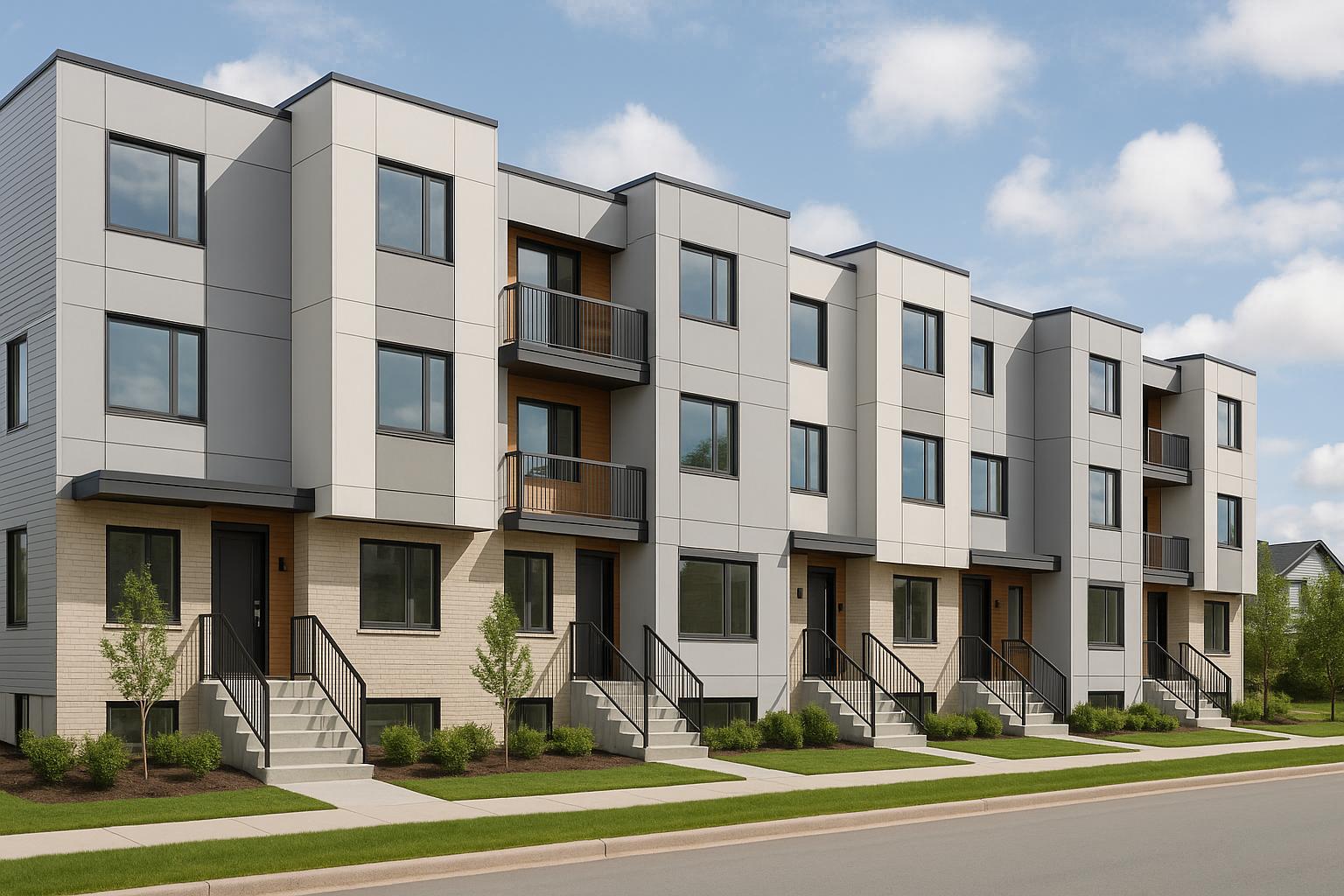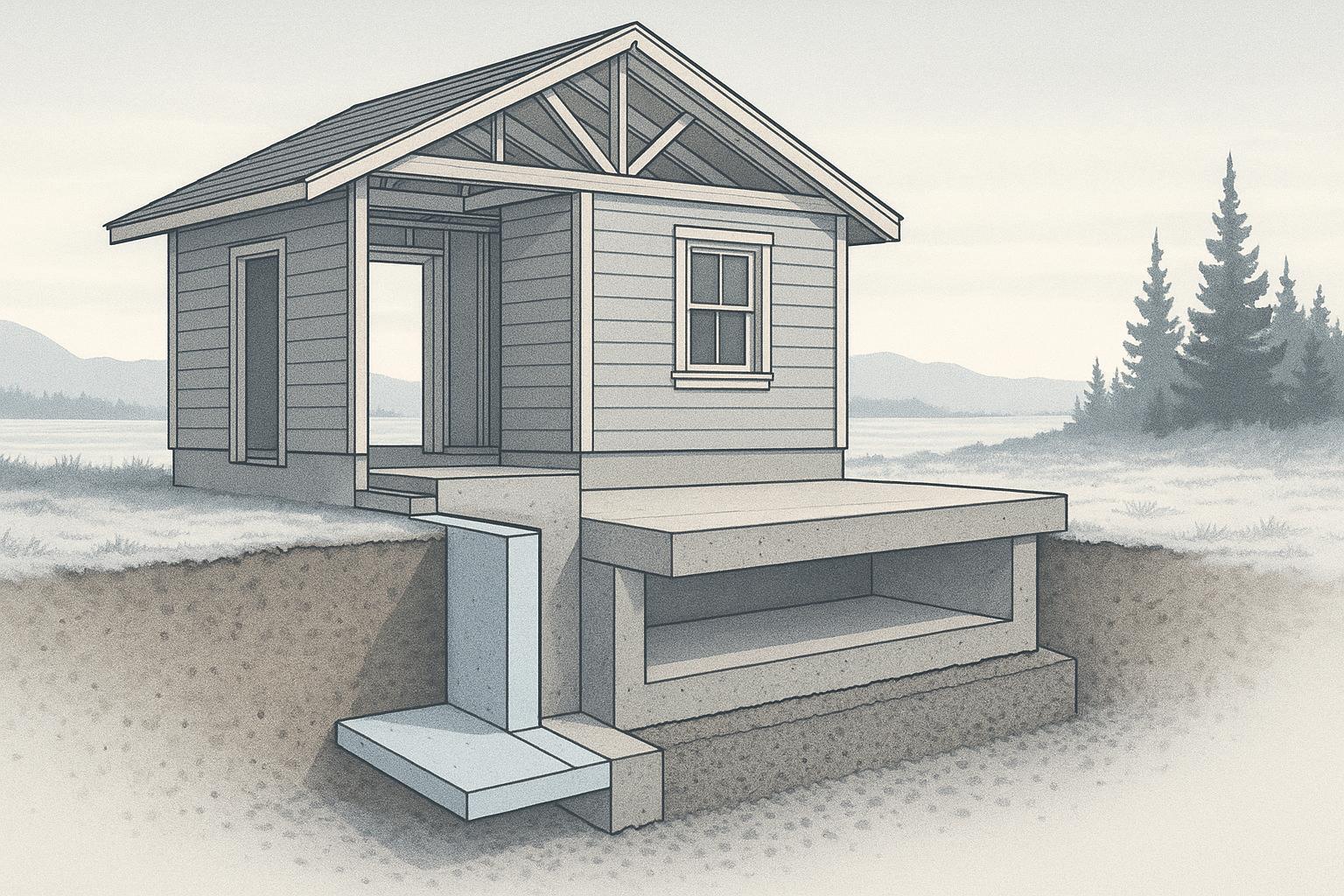ER-3 zoning in Halifax offers opportunities for multi-unit residential projects, but poor planning can lead to costly mistakes. From grading issues that cause drainage failures to entrance missteps that violate fire codes, errors can derail your project. Corner lots, while offering flexibility, require careful design to avoid wasted space or approval delays. Integrated design-build methods can save time, money, and headaches compared to fragmented construction approaches. Here's what you need to know to avoid common pitfalls:
- Grading Problems: Poor drainage, accessibility violations, and utility conflicts are frequent issues. Early involvement of engineers and soil testing can prevent costly fixes.
- Entrance Design: Misaligned entrance widths or fire exit planning can cause compliance issues. Plan entrances early to meet zoning and fire codes.
- Corner Lots: Dual street access is an advantage, but improper use can lead to inefficient layouts. Strategically position entrances and maximize usable space for better outcomes.
- Construction Approach: Traditional fragmented methods often lead to delays and higher costs. Integrated design-build offers faster timelines, fewer change orders, and fixed pricing.
Avoiding these mistakes requires expertise and a proactive approach to planning. Below, we break down each challenge and how to address it effectively.
Site Grading Problems in ER-3 Multi-Unit Projects
Site grading is one of the most pressing design challenges in ER-3 developments. Poor decisions during this phase can lead to foundation issues, ongoing maintenance headaches, and expensive fixes.
Grading Problems That Can Drain Property Owners' Budgets
Drainage failures are a frequent issue in ER-3 projects. When grading doesn’t properly channel water away from the building, it can lead to foundation damage, basement flooding, and costly remediation. In areas with challenging soil conditions, poor water management can even cause foundation settling, resulting in significant repair bills.
Accessibility code violations are another common concern. The National Building Code mandates accessible entrances for multi-unit buildings. However, a poorly graded site can make compliance impossible without major redesigns or expensive modifications. Discovering these issues late in the project can be a costly mistake.
Dimensional standard conflicts occur when grading disregards setback requirements. ER-3 zoning regulations specify minimum distances from property lines. If grading breaches these setbacks, it can force redesigns or even reduce the number of units, cutting into rental income.
Utility connection problems can arise when grading doesn’t align with municipal infrastructure needs. Incorrect grading may violate utility connection requirements, leading to additional excavation and higher costs.
Parking and access issues often stem from steep or uneven grading. Poorly designed driveways can become unsafe, especially in winter, creating liability concerns and reducing tenant satisfaction.
Preventing Site Grading Problems from the Start
Tackling grading challenges early in the process is essential to keep costs under control and ensure a functional design.
Involve a civil engineer early. Bringing a Professional Engineer into the project at the initial stages can help identify potential grading issues before they derail the design. Their expertise ensures site constraints are addressed upfront, avoiding surprises later.
Opt for integrated design-build teams. Collaboration between architects, engineers, and construction teams from the outset can prevent coordination gaps. This approach aligns grading decisions with both the design vision and construction requirements, reducing inefficiencies.
Conduct thorough site analysis. Invest in soil testing, drainage studies, and utility mapping before starting the design. With the region’s diverse soil conditions, a tailored grading strategy is often necessary to avoid expensive surprises.
Follow local bylaws and account for Nova Scotia’s climate. Consider freeze-thaw cycles and spring runoff during grading to avoid compliance issues and early maintenance problems.
Use precise metric measurements. Ensure accuracy by using metres for elevations and percentages for slopes, which helps prevent costly errors.
Treating grading as a core design element, rather than an afterthought, is critical for successful ER-3 projects. By addressing these challenges early, property owners can ensure their developments are compliant, efficient, and built to last.
Entrance Count Rules: Meeting Code While Keeping Tenants Happy
Designing ER-3 entrances in Nova Scotia requires a careful balance between meeting zoning codes and creating functional spaces. Missteps can lead to inspection failures, wasted interior space, and even a loss of planned units.
ER-3 Entrance Rules and Common Mistakes
ER-3 zoning rules in Nova Scotia set limits on the number of entrances based on street frontage and building layout. The requirements vary for grade-oriented premises compared to traditional apartment-style entrances, and misunderstandings of these rules often lead to compliance headaches.
One common mistake is neglecting fire exit requirements during the design phase. Failing to plan for proper egress paths and exit widths not only violates building codes but can also waste interior space and reduce the number of units that can be included [1].
Another frequent issue arises when entrance widths for grade-oriented units exceed the maximum allowed by regulations. While wider entrances might seem visually appealing, going beyond the permitted dimensions can result in permitting challenges [1].
These examples underline the need to incorporate zoning and code requirements into the design process from the very beginning.
How to Design Entrances That Work
To avoid these pitfalls, ensure that your entrance designs align with fire exit and width standards right from the start. This means integrating fire exit planning into the initial layout and adhering to the maximum width limits for entrances. Addressing these considerations early can save time, prevent costly redesigns, and avoid delays in securing permits.
Corner-Lot Design in ER-3 Zones
Corner lots in ER-3 zones come with the advantage of dual street access, but they also require careful planning to maximize their potential. Just like grading and entrance placement, designing for corner lots plays a critical role in achieving success with ER-3 projects.
Benefits and Challenges of Corner Lots
Corner lots bring dual street access, which offers flexibility in placing entrances and orienting units. This layout often allows for more natural light, making the units more appealing to renters and potentially increasing rental income. The extra street frontage also opens the door to creative building designs, helping developers fit the maximum number of units allowed under ER-3 density rules.
That said, corner lots aren’t without their challenges. One common issue is wasted building envelope space. If the design doesn’t take full advantage of the corner layout, you might end up with awkward floor plans or underutilized outdoor areas.
Streetscape design can also be tricky. Builders sometimes focus too much on one street frontage and neglect the other, leading to an unbalanced look that doesn’t blend well with the neighbourhood. This imbalance can even cause delays or problems with municipal approvals.
Dual street access, while a benefit, can complicate decisions about parking and entry points. Without proper planning, issues like unclear primary entrances or inefficient traffic flow can lead to tenant complaints or operational headaches.
The good news? These challenges can be turned into opportunities with smart design strategies.
Effective Corner Lot Design Strategies
To make the most of a corner lot, focus on design solutions that enhance both functionality and appeal.
- Thoughtful entrance placement: Position the primary entrance on the street with higher visibility or traffic, while using the secondary street for parking access or additional entrances. This creates a strong street presence without sacrificing practicality.
- Wrap-around features: Use design elements like porches or balconies that span both street frontages. These not only highlight the corner layout but also provide tenants with extra outdoor spaces, which can be a big draw.
- Efficient use of space: Plan every square metre carefully to avoid wasted areas. Ensure all measurements in design documents use metric units to prevent permitting errors.
- Unified landscaping: Design landscaping that ties both street frontages together. Avoid treating one side as the "back" by creating cohesive outdoor elements that meet municipal guidelines for both streets.
- Premium corner units: Take advantage of the corner positioning to create standout units. With natural light from two sides and better views, these units can be designed as premium offerings, featuring slightly larger layouts or upgraded finishes to justify higher rents.
- Setback planning: When dealing with two street frontages, setbacks may differ. Identify these requirements early and use the overlap strategically to position the building in a way that maximizes usable space while staying compliant with city regulations.
sbb-itb-16b8a48
Integrated vs Fragmented Construction for ER-3 Projects
When it comes to ER-3 projects, decisions about construction methods go far beyond site grading and entrance planning - they can make or break your project's success. Many property owners stick with the traditional fragmented construction approach, which often leads to coordination headaches and inflated costs. On the other hand, an integrated design-build method offers a more streamlined and predictable way to achieve your goals.
Problems with Fragmented Construction
The traditional Design-Bid-Build approach divides the project among separate architects, engineers, planners, and contractors. While this might seem straightforward, it often creates significant issues with timelines and budgets.
Here’s why: in a fragmented setup, each party focuses only on their specific role. For instance, architects may design without considering construction limitations, engineers’ plans may not align with how contractors build, and critical issues often surface only after construction begins. This disjointed process leaves you, the property owner, to sort out the inevitable gaps.
The numbers speak for themselves - traditional projects typically face change orders adding 8–15% to the total project cost[2]. These issues arise from isolated design decisions that don’t account for real-world construction challenges. What’s more, an ER-3 project initially planned for eight months can easily extend to 18 months or more. Every additional month of delay could mean losing out on rental income, adding further pressure to your investment.
Another major downside? Fragmented construction creates an accountability void. When delays or cost overruns occur, responsibility is often passed from one party to another, leaving you to deal with the fallout.
How Integrated Design-Build Fixes These Problems
An integrated design-build approach offers a way to sidestep these challenges and deliver more reliable results. By bringing all team members - designers, engineers, and contractors - under a single contract, this method ensures seamless coordination and accountability from start to finish.
With one company overseeing your ER-3 project, you eliminate the finger-pointing common in fragmented setups. For instance, companies like Helio Urban Development offer guarantees, such as completing construction in six months or facing penalties of up to $1,000 per day for delays. This level of commitment provides a certainty that traditional methods simply can’t match.
Cost predictability is another big advantage. Because the same team handles both design and construction, potential issues are identified and resolved early on. This proactive approach reduces change orders to just 3–8% of the project cost, compared to the 8–15% typical in fragmented projects[2]. Fixed pricing is established before construction even begins, giving you a clear financial picture.
Integrated design-build also speeds up the process. By overlapping design and construction phases, projects are completed 40–50% faster, cutting total duration by 15–20%[2][3]. This means you can start earning rental income much sooner.
Here’s a quick comparison of the two approaches for a typical $640,000 ER-3 fourplex:
| Factor | Fragmented Construction | Integrated Design-Build |
|---|---|---|
| Timeline | 8–18+ months | 6 months guaranteed |
| Change Orders | 8–15% ($51,200–$96,000) | 3–8% ($19,200–$51,200) |
| Accountability | Multiple parties, frequent disputes | Single-source responsibility |
| Cost Certainty | Unpredictable budgeting | Fixed price upfront |
Quality also improves when teams work together from the start. Integrated projects often include quality checks at critical stages, ensuring problems are caught early rather than during final inspections. This collaborative approach reduces the need for last-minute fixes and ensures a smoother process overall.
Another benefit? Less administrative hassle. Instead of juggling multiple contracts and teams, you can focus on your investment strategy while the integrated team handles all internal coordination. Every aspect of your project is aligned, from design to completion.
Conclusion: Avoiding ER-3 Design Mistakes
Navigating ER-3 zoning successfully demands a solid understanding of the rules and the involvement of skilled builders. Overlooking common design mistakes can disrupt your timeline and inflate your budget if not addressed early.
The foundation of avoiding these setbacks lies in careful planning and a deep understanding of local regulations. The Halifax Regional Municipality's ER-3 zoning has specific standards that must be followed to the letter [4]. Builders familiar with these rules know the finer details, like how "grade" is defined for height calculations, the requirements for entrance numbers and orientations, and the unique setback rules for corner lots with dual front yards. This kind of expertise is a cornerstone of the integrated design-build approach discussed earlier. It ensures compliance from the start, helping to avoid the need for costly redesigns or revisions.
Experienced local builders also bring the advantage of smoother permit approvals and fewer construction delays. Delays can quickly add up, especially in terms of lost rental income. Builders who are well-acquainted with Nova Scotia's regulations and Halifax's planning department processes deliver more predictable results. Their integrated design-build approach offers a more streamlined experience compared to traditional construction methods, which often feel fragmented and inefficient.
When it comes to ER-3 zoning, working with professionals who understand every detail is not just helpful - it’s essential. Without this expertise, costly errors are almost inevitable in multi-unit developments.
FAQs
Why is it important to involve a civil engineer early in ER-3 zoning projects to address site grading?
Getting a civil engineer on board early in your ER-3 project can make a world of difference in avoiding typical grading problems. They’ll evaluate the site for key aspects like drainage, soil stability, and zoning compliance, ensuring everything is set to meet ER-3 standards right from the beginning. This proactive approach can help you sidestep expensive errors, delays, or the need for rework during construction.
By tackling grading issues early, a civil engineer can also refine the design to enhance both functionality and durability over the long term. This not only saves you time and money but also boosts the overall success of your multi-unit development.
What are the advantages of using an integrated design-build approach for ER-3 multi-unit developments?
An integrated design-build approach simplifies the entire process by bringing design and construction under one team. This setup helps cut down on delays, avoids miscommunication, and minimizes unexpected problems. The result? Projects are completed faster, and workflows are much more seamless.
It also helps manage costs effectively by spotting potential challenges early and planning ahead. With improved coordination and teamwork, this approach leads to more predictable results, fewer hiccups during construction, and smarter use of resources - all crucial for getting the most out of ER-3 developments in Nova Scotia.
How can I make the most of a corner lot in an ER-3 zone while avoiding common design mistakes?
To make the most of a corner lot in an ER-3 zone, start by planning the layout thoughtfully, keeping in mind local setback rules and lot coverage limits, which usually fall between 40% and 60%. Place buildings strategically to make the best use of street frontage and provide easy access. At the same time, incorporate landscaping to boost privacy and improve curb appeal.
Be mindful of building height and overall size to avoid overshadowing nearby properties and to preserve the area's character. By steering clear of overbuilding and focusing on a design that blends well with the surroundings, you can achieve a practical, compliant, and visually pleasing development that takes full advantage of the corner lot's potential.



